35+ Sample End User License Agreement
-
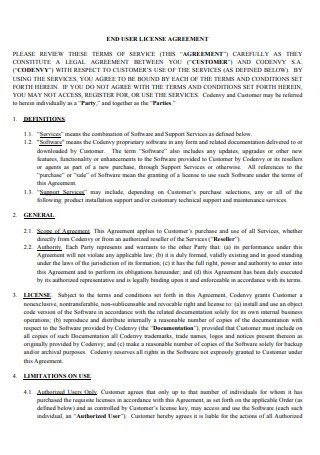
End User License Agreement Template
download now -
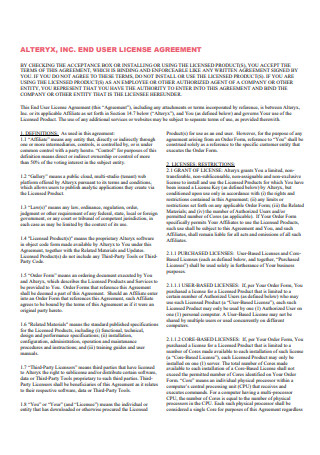
Sample End User License Agreement
download now -
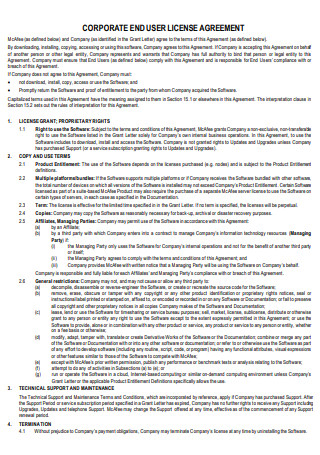
Corporate End User License Agreement
download now -
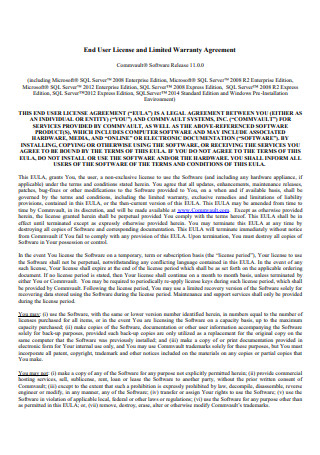
End User License and Limited Warranty Agreement
download now -
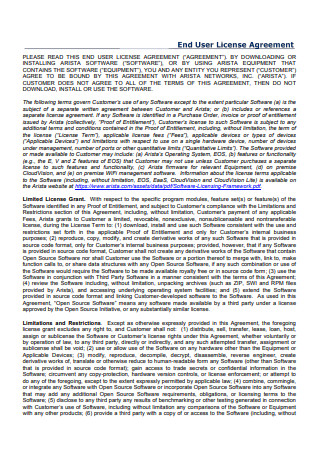
Basic End User License Agreement
download now -
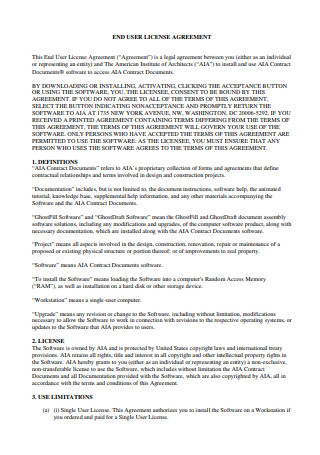
End User License Agreement in PDF
download now -
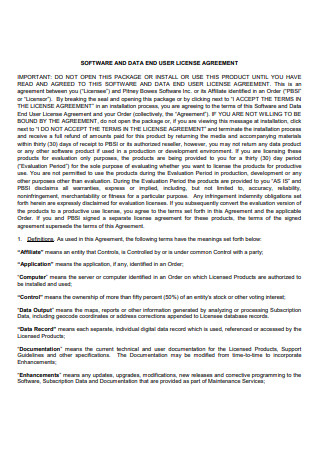
Software and Data End User License Agreement
download now -
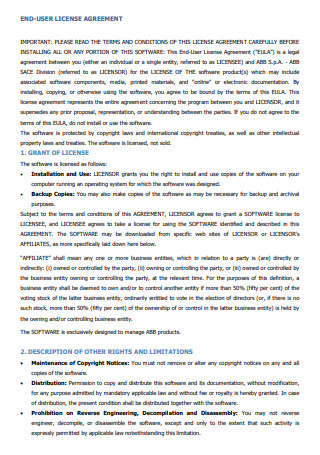
End User License Agreement Example
download now -
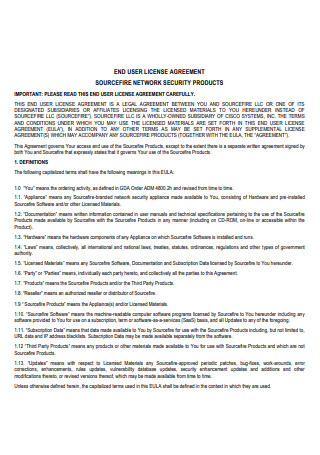
End User License Legal Agreement
download now -

Formal End User License Agreement
download now -
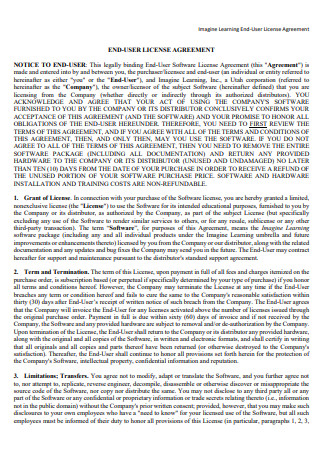
Learning End User License Agreement
download now -

Supplemental End User License Agreement
download now -
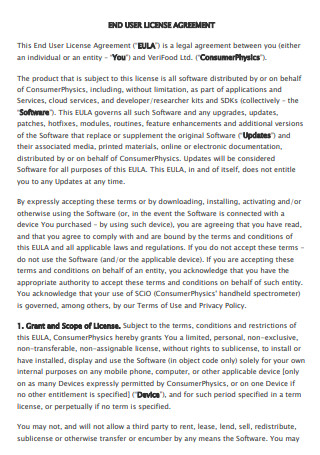
Individual End User License Agreement
download now -
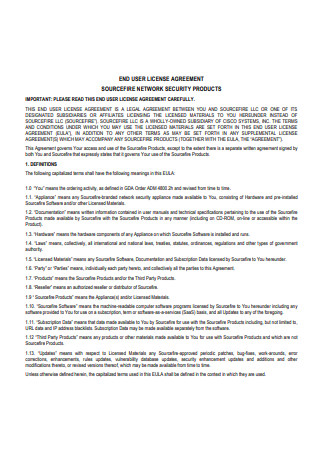
Network End User License Agreement
download now -
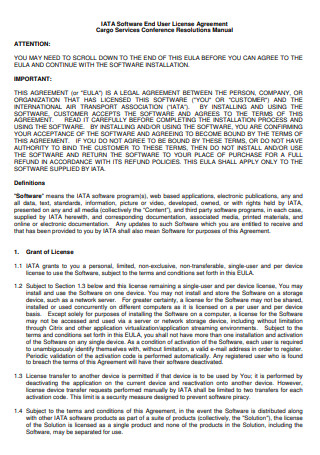
Software End User License Agreement
download now -

Corporation End User License Agreement
download now -
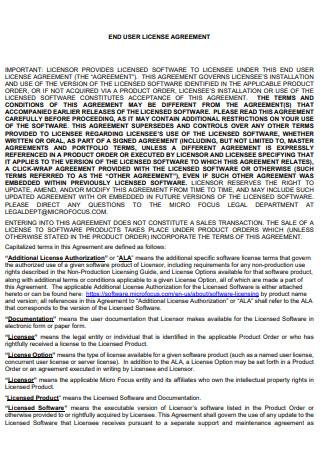
End User License Installation Agreement
download now -
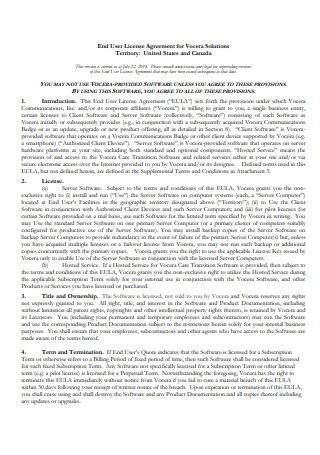
End User License Agreement for Solution
download now -
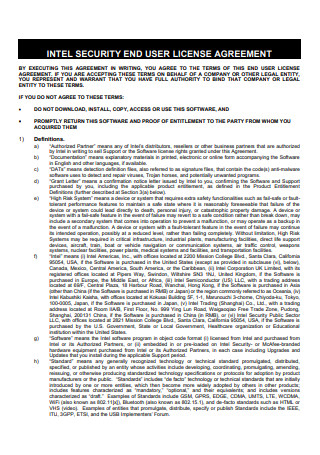
Security End User License Agreement
download now -

Standard End User License Agreement
download now -
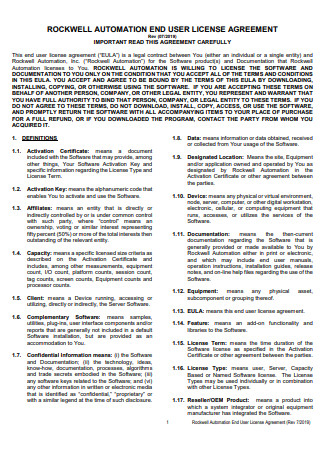
Automation End User License Agreement
download now -
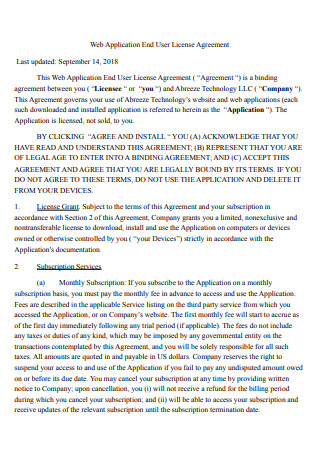
Web Application End User License Agreement
download now -
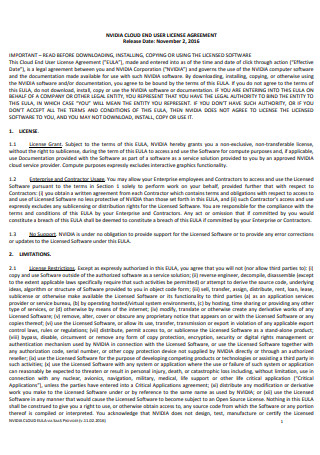
Cloud End User License Agreement
download now -
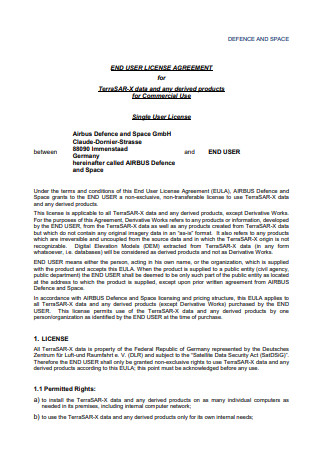
Defense and Space End User License Agreement
download now -
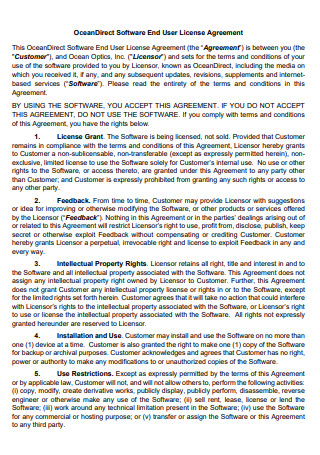
Direct Software End User License Agreement
download now -
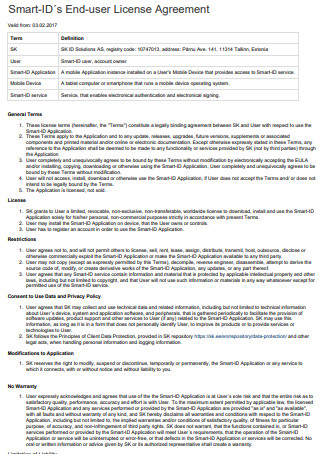
Smart ID End User License Agreement
download now -
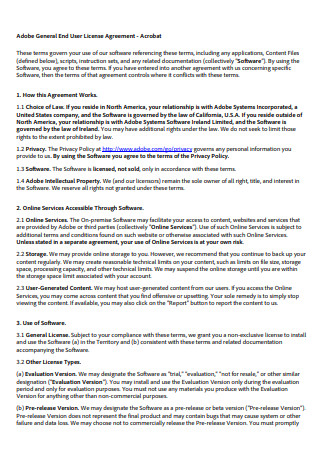
General End User License Agreement
download now -
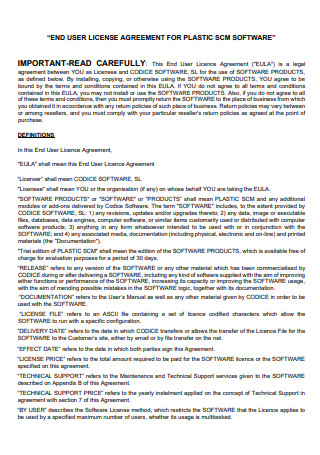
End User License Agreement For Plastic Software
download now -
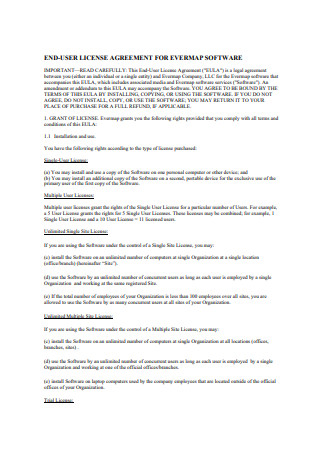
End User License Agreement For Map Software
download now -

End User License and Service Agreement
download now -
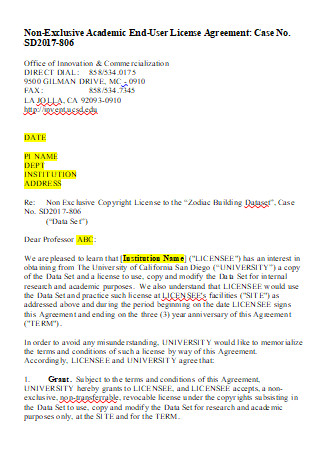
Non-Exclusive Academic End User License Agreement
download now -
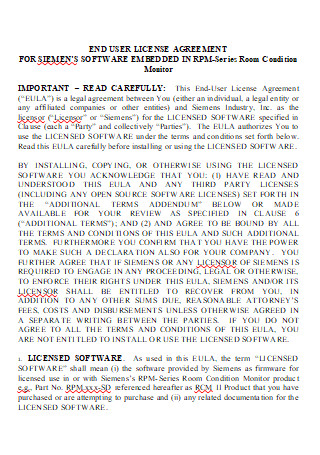
Printable End User License Agreement
download now -
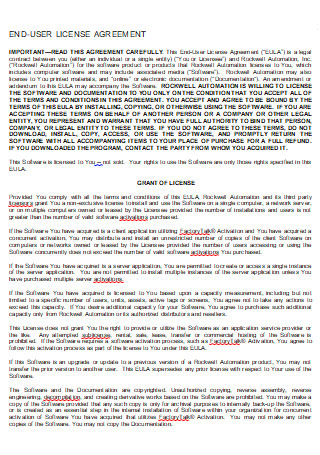
Simple End User License Agreement
download now -
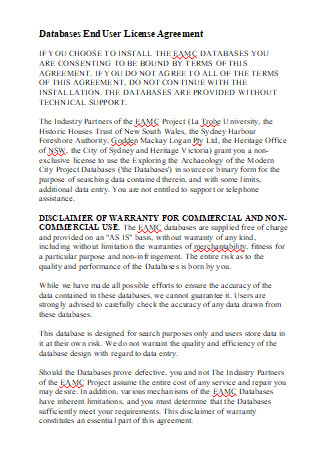
Database End User License Agreement
download now -
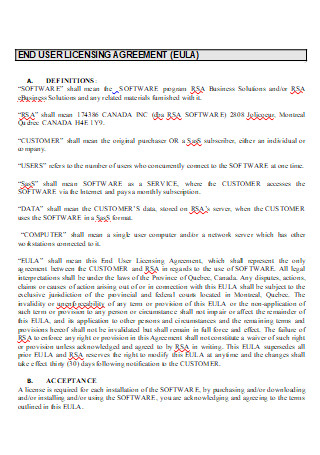
End User Licensing Agreement Format
download now -
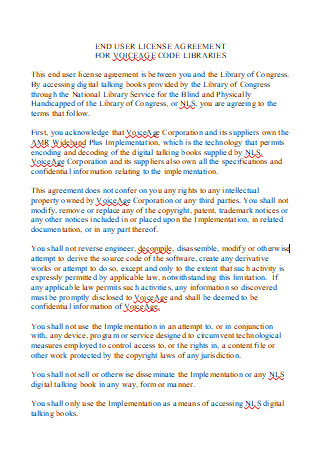
End User License Agreement in DOC
download now
FREE End User License Agreement s to Download
35+ Sample End User License Agreement
What Is an End-User License Agreement?
Components of an End-User License Agreement
Relevant Clauses of an End-User License Agreement
How to Write an End-User License Agreement
FAQs
What is the similarity of a EULA to terms of use or terms of service agreement?
Are there disadvantages to a EULA?
Why is a EULA necessary, and what benefits does it bring to your company?
What are the consequences of not using a EULA?
Where do you commonly see the use of EULA?
Just because an individual purchases software under their name does not mean there are no sanctions for the misuse of the program. Chances are, individuals are familiar with an end-user license agreement. However, not many people read through them, even if they contain essential statements and provisions. It’s necessary to be aware of an end-user license agreement as various stipulations must be considered. Learn about the end-user license agreement, including its definition, components, and construction, by understanding the following article.
What Is an End-User License Agreement?
An end-user license agreement (EULA) is considered a legal contract between software developers and the software user through a purchase made by a user to a retailer of a given product. The EULA details the rights and restrictions that pertain to handling software, similar to a term of services agreement. Software companies utilize the use of these agreements as a means to protect themselves by requiring users into the company’s terms, rules, and guidelines. The EULA is present with any developed software application regardless of the platform intended for use, whether on computers, cellular phones, or game consoles. An end-user license agreement is also known as a software license agreement. Most of these contracts are present in digital form and are visible as a click-through that allows the users to agree or disagree.
According to an article published through businessinsider.com in November 2017, a hosted survey by Deloitte shows that 91 percent of American consumers accept legal terms and conditions of an agreement without reading them, and participants aged 18 to 34 years old produce a rate of 97 percent.
Components of an End-User License Agreement
While the elements of an end-user license agreement vary depending on the product, the EULA must contain the following general components:
Relevant Clauses of an End-User License Agreement
There are vital clauses that must be present in all end-user license agreements. These statements address the permission of use, infringement clauses, restrictions, terminations, and other limitations and disclaimers regarding the license usage. Listed below are the essential descriptions in end-user license agreements:
How to Write an End-User License Agreement
As the EULA protects the software creator and the licensor, the company must provide a well-written and curated document. After having an idea of what a EULA contains, it’s time to create one for your company. Here are helpful steps to follow in writing an end-user license agreement for the company or yourself.
Step 1: Identify Yourself or Your Business Clearly
EULAs must begin with a simple introduction. It must introduce details, including the name of the application or program, the company name, and all other names and affiliates under the scope of the conditions of the agreement. A definition of terms is present, with references to any additional terms in the span of the document. It is necessary to include that the document is a legal arrangement between the user and the software company. Ensure that users understand the introduction by indicating they agree and accept your agreement.
Step 2: State the Rules for User Behavior and Access to the Product
Continue writing your EULA with the use and restriction of the license, letting the user know they can use your product and the extent they can make use of it. It is also advisable to stress that the user only has access to the license, and you did not sell your program. Restrictions regarding the use of the program must cover all the principles of the activities you wish to limit. The section details usual restrictions on use, including spam, illegal manufacturing, profiting, copying portions of the software, and violating laws using the software. You also have the freedom to structure your clauses in a way that is clear to your consumers, whether it is by using sub-categories or sub-headings.
Step 3: Disclose the Copyright License That Applies to the Program
Always incorporate a section that informs your end-users that your products or materials are under the protection of copyright laws. Include necessary items to be covered, from the software to relating documents.
Step 4: List Other Details of Software Licensing and Conditions of Termination
It is wise to create a termination of use clause. It states that when a user violates any conditions specified in the end-user license agreement or any relating agreements you have and wish to include, or through your discretion, you have the right to terminate and remove the program from the user’s device.
Step 5: Include Disclaimers and Limitation of Liability Statements
Indicating a warranty disclaimer helps make it clear to your users that the software comes as it is and that you do not guarantee anything beyond the minimum requirement by law. It is also ideal to use easily understandable language. Use a limitation of liability clause to let your users know that you are not liable for any damages that may arise when using your program, as well as the damage to the device they are using. Write a section that acknowledges the application of limitations at the greatest enforceable extent under applicable laws covering the license agreement.
FAQs
What is the similarity of a EULA to terms of use or terms of service agreement?
By definition, the terms of use agreement, similarly called terms and conditions or terms of service, dictates the relationship between an entity, its product or service, and the consumer. It includes everything from copyright and licensing to consumer rights, return policies, and even the governing laws of the agreement. The EULA operates the same way, but the focus centers on the licensing relationship between the developer and the user. These titles are often interchangeable and concern products like software, applications, and programs.
Are there disadvantages to a EULA?
EULAs are often lengthy, hard to decipher, and brimming with legal jargon that most people completely ignore its context before agreeing to its terms. However, not thoroughly reading the content leading to impactful consequences, leading to computer viruses, phishing scams, identity theft, and other technical issues.
Why is a EULA necessary, and what benefits does it bring to your company?
The EULA provides a legal way for the licensee to buy or rent the use of a product with specific limitations. As the company that developed the program earns money from its use or rent, they also control its parameters. Through it, the licensor prevents users from making illegal changes to the product or copying it for unauthorized distribution. It establishes your property rights to the software, protecting the company’s intellectual property. It also safeguards you and the company from any impending lawsuits on the basis that terms were not read. It also clarifies the exemption of the developer from responsibility when devices malfunction under the limitation of liability.
What are the consequences of not using a EULA?
Without the perimeters set by a EULA, a software creator instantly agrees to a free and open-source software license. In this type of situation, the future versions of the software must remain unrestricted for distribution. The EULA protects the source code and written program, mobile application, software, and computer program from being reproduced without permission. Without it, users who obtain the product can modify, adapt, improve, enhance, translate, or derive works from the original software.
Where do you commonly see the use of EULA?
If your company handles internet websites, mobile applications, software applications, and computer programs, you benefit from creating a license agreement for your consumers before giving them access to your product.
Companies issue agreements for various reasons. Mainly, these legal documents protect their intellectual properties and limit their liabilities. Organizations must utilize these papers, especially when it comes to their merchandise and services. End-user license agreements are helpful to companies handling technological products like websites, mobile and software applications, and computer programs. To software developers, their intellectual creativity is their treasure and must be well protected, especially when competitors try to succeed over others. In the words of Steve Jobs, “Creativity is just connecting things. When you ask creative people how they did something, they feel a little guilty because they didn’t really do it, they just saw something. It seemed obvious to them after a while.” Protect your business by implementing an end-user licensing agreement through the use and download of the samples above.
